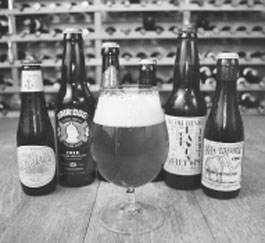Barley Wine is the strongest of beers and while not always literally approaching the alcohol content  of wine, usually surmounts the strength of ales referred to as “strong” and “old,” to which they are related.
of wine, usually surmounts the strength of ales referred to as “strong” and “old,” to which they are related.
The early development of the barley wine beer style began in the mid to late 18th century in breweries attached to aristocratic great houses in England. At first, such beers were too expensive to produce on a commercial basis. Using new techniques to produce pale malts, they began to brew very strong ales exclusively for the use of these wealthy households. In 1736 the seminal book The London and Country Brewer makes mention of very strong ales brewed “as to be of a Vinous Nature.” These beers would often be aged in wood for a year or more before serving, and were brewed “to answer the like purpose of wine” at the table. This was considered important in the days when difficulties between England and the wine-producing countries to the south could interrupt wine supplies for extended periods of time.
In 1854 the brewers Bass, Ratcliff, & Gretton of Burton upon Trent began production of a single-brew barley wine they called simply No. 1, its label adorned with a single red diamond. This diamond was registered as Britain’s second trademark, following the still-familiar Bass Ale red triangle. The dark beers of Bass bore a brown diamond. No. 1 was a ponderously strong beer, beginning its fermentation at a specific gravity of 1.100 (about 25° Plato). No. 2, another barley wine, was somewhat smaller at 1.097. Bass No. 1, as it is still known, was brewed almost continuously (with a 10-year break from 1944 to 1954) until its discontinuation in 1995. It remains the standard (though today only in memory) against which other British barley wines are measured.
Bass No. 1 was distinctive not only for its single brew method of production but also for its paleness, owing in part to increased understanding of the economic feasibility of pale malt. Prior to this development, barley wines had been mainly dark amber to brown in color, employing more cheaply available darker malts. Other brewers followed suit with pale versions such as Tennent’s Gold Label and Fuller’s Golden Pride. A dark and noteworthy barley wine, Thomas Hardy’s Ale, has been produced by a succession of brewers, beginning with Eldridge Pope in 1968 and concluding in 2009 at O’Hanlon’s Brewing Co.
With its roots in British traditions, barley wine as a style enjoyed a substantial second flowering among American craft brewers, beginning with the production by Anchor Brewing Co. of its Old Foghorn in 1975, and followed shortly afterward by Sierra Nevada Brewing’s Bigfoot. Within several years barley wine had become something of a seasonal showoff among small American brewers, who released small batches of it for the Christmas season as thanks for loyal patronage throughout the year. It can be argued that as barley wine production in the UK has waned since the discontinuation of Bass No. 1 and others, the American craft brewing scene has been instrumental to maintaining the vitality of the style.
For the brewer, barley wine is a difficult and expensive beer to produce, requiring great amounts of materials, procedural vigilance, and time, which it may be said constitutes the fifth vital element of its production (along with malt, hops, water, and yeast). Like its early cousins old and strong ale, barley wine is intended to be laid down, the fortitude of its flavors sometimes requiring a year or more to mellow to an enjoyable integration. Its alcoholic strength also commonly prescribes its sale in small glasses and six-ounce “nip” bottles.
A range of interpretation exists across barley wine’s geography, not only between British and American versions but from one side of the North American continent to the other. Generally and historically, and no doubt owing in part to the relative proximity of supply, the barley wines of the West Coast are substantially hoppier than their eastern counterparts. Where British examples are noteworthy for pronounced alcoholic and sherry-like flavors, a pure-bred northwest US version is fierce in hop bitterness and aroma, even after the time ordinarily counted upon to diminish hop character. The American Northeast, with perhaps stronger ties to UK brewing traditions and tastes, generally produces barley wines in a kind of mid-Atlantic meld, tending more to the sweet and strong, with tempered flavors of age.
In a sort of historical resonance with the emergence in the mid-19th century of barley wines paler than their antecedents, American barley wines in the 1990s took a turn for the paler as well. This, combined with the fierce hop qualities evident in the bolder examples, took the first steps toward the development of a new style whose other parent was India pale ale. Double, or “Imperial” IPAs displayed the alcoholic strength of barley wine along with the layers of hop bitterness, flavor, and aroma long associated with IPA, another staple of American craft brewers arguably rescued from the scrap heap of British brewing tradition.
The London and country brewer, 2nd ed. 1736. http://www.pbm.com/∼lindahl/london/. This is a scanned copy and is also available as a single pdf file at http://www.pbm.com/∼lindahl/london/all.pdf/.

American barley wines. charles finkel
